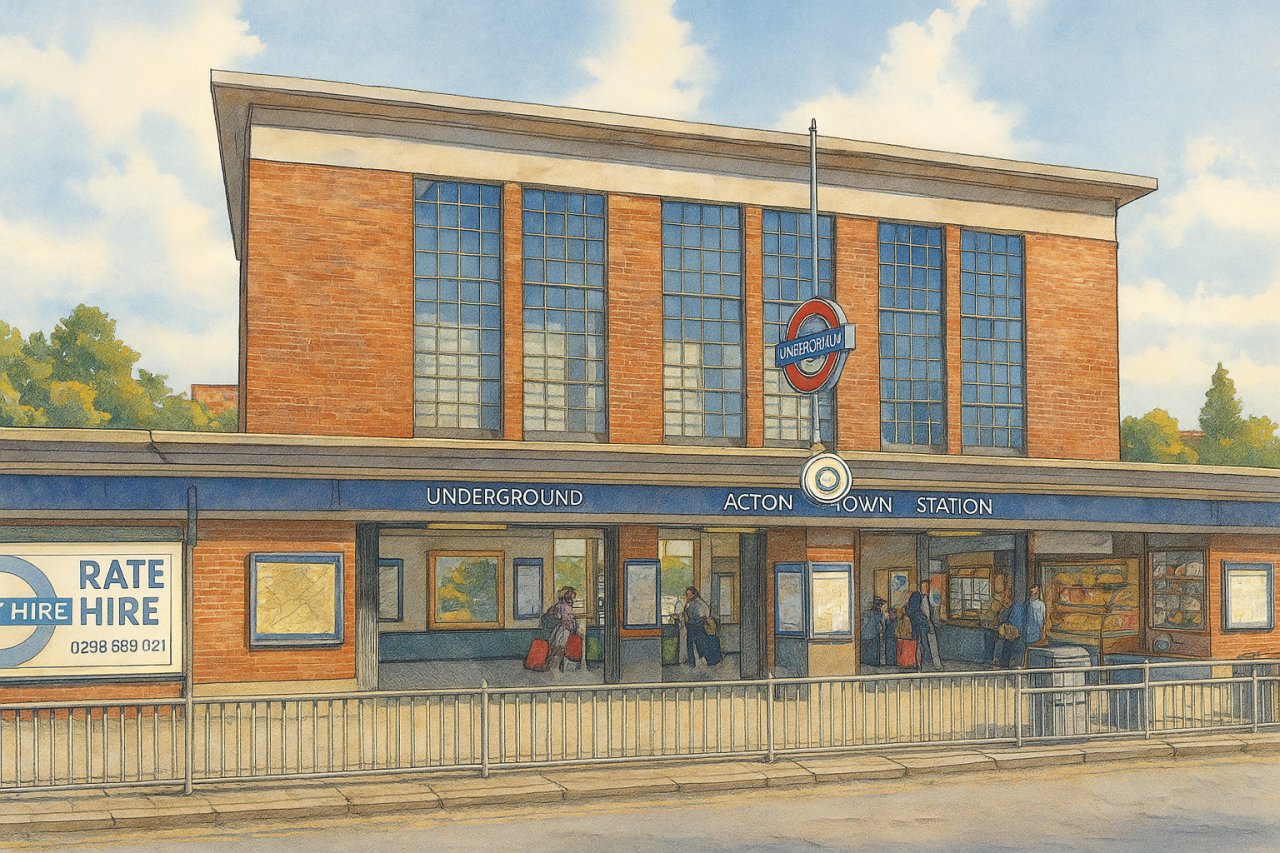
Acton Town Station, London
Acton Town Station – A Historic West London Tube Stop
Acton Town Station is a prominent London Underground station located in the west of the city, within the London Borough of Ealing. Nestled in the heart of the residential area of Acton, it provides convenient access for both locals and visitors, serving as a vital interchange for the District and Piccadilly lines.
Location and Accessibility
Acton Town Station lies in West London, within fare zone 3. It is situated on Gunnersbury Lane (A4000), near the junction with Bollo Lane. The station is roughly 7.5 miles (12 km) west of Charing Cross by road, making it easily reachable by car or public transport. The surrounding area is largely residential, with good local amenities and green spaces.
Brief History
The station was originally opened on 1 July 1879 as Mill Hill Park by the District Railway (now the District line). It was renamed Acton Town on 1 March 1910 to better reflect the local area and its connection to the growing suburban community of Acton.2
As part of the London Underground’s electrification and modernization, the station underwent major reconstruction in the early 1930s. The present station building was designed by renowned architect Charles Holden and was completed in 1932. It is a fine example of Holden’s modernist style, with clean lines, functional form, and the use of Portland stone and glazed bricks.1
Acton Town’s station building is a celebrated example of early 20th-century London Underground architecture. Charles Holden’s design has earned it Grade II listed status from Historic England, recognizing its architectural significance and historic value.1
Staff are present at the station throughout operational hours, and real-time service updates are available via platform displays and TfL apps.3
The Name and Pronunciation
The name Acton comes from the Old English words āc (oak) and tūn (farm or settlement), meaning "oak farm" or "farm by the oaks." The area has been known by this name since at least the 13th century.
Acton is pronounced AK-tən, with the stress on the first syllable. In the International Phonetic Alphabet (IPA), it is written as /ˈæktən/. 
Services and Lines
Acton Town is served exclusively by the London Underground. It is a key stop on two of the network’s major lines:
Piccadilly Line
- Preceding station: Hammersmith (eastbound)
- Subsequent stations: South Ealing (towards Heathrow) and Ealing Common (towards Uxbridge)
The Piccadilly line splits west of Acton Town. Trains heading west may either continue toward Heathrow Airport or toward Uxbridge. Acton Town is the last point before this split, making it an important interchange station.
District Line
- Preceding station: Chiswick Park (eastbound)
- Subsequent station: Ealing Common (westbound)
On the District line, Acton Town lies on the Ealing Broadway branch. Trains from central London pass through here before heading further west.
Architectural and Cultural Interest
Acton Town’s station building is a celebrated example of early 20th-century London Underground architecture. Charles Holden’s design has earned it Grade II listed status from Historic England, recognizing its architectural significance and historic value.
The station features large glazed panels, elegant curves, and a distinctive ticket hall with high ceilings, capturing the spirit of London’s transport modernization in the 1930s. For architecture enthusiasts, it’s well worth a look even without taking a train.
Fun Fact
Acton Town is unique in that it has a total of five other stations in the local Acton area: Acton Central, Acton Main Line, South Acton, East Acton, and West Acton. This gives Acton the distinction of having the most railway stations with the same area name in all of London—a testament to its once strategic location in the capital’s rail development.
Another fun quirk is that westbound Piccadilly line trains announce “This train will divide at Acton Town.” Though this feature is rarely used today, the announcement hints at the station's historic operational complexity.
Station Facilities
Acton Town Station is equipped with:
- Ticket machines and Oyster card top-up points
- Step-free access from street to platform (eastbound platform only)
- Toilets and a small kiosk
- Wi-Fi access for London Underground customers
Staff are present at the station throughout operational hours, and real-time service updates are available via platform displays and TfL apps.
Nearby Attractions and Connectivity
While Acton Town itself is primarily a residential hub, it offers access to several local points of interest, including:
- Gunnersbury Park – A large historic park and museum
- Chiswick High Road – Lined with restaurants, shops, and pubs
- Acton Market – A small but lively community market near the town centre
The station is also well-connected by local bus services, including routes 70 and E3, offering further access to Ealing, Chiswick, and Shepherd's Bush.
Quick Facts
- Opened: 1 July 1879 (as Mill Hill Park)
- Renamed: 1 March 1910 (to Acton Town)
- Location: Gunnersbury Lane, London Borough of Ealing
- Distance from Charing Cross: Approximately 7.5 miles (12 km) by road
- Lines served: District and Piccadilly (London Underground)
- Station type: Underground (no Overground or National Rail services)
- Pronunciation: AK-tən /ˈæktən/
- Fun fact: One of six stations in London with "Acton" in the name
- Architect: Charles Holden (1932 rebuild)
- Listed status: Grade II
References
- Historic England – Acton Town Station Listing
- London Transport Museum – Acton Town History
- TfL – Acton Town Underground Station
Acton Town Station is  on the Map of London Underground
on the Map of London Underground

Painting of Acton Town Station, London (View image in full size)